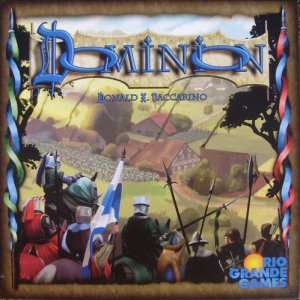Introduction to Dominion
My first post on this brand new blog devoted to Statistics is going to be a board game I recently discovered, Dominion.
My first post on this brand new blog devoted to Statistics is going to be a board game I recently discovered, Dominion.
And, surprisingly, there will be no statistics. Why? First, because this site is not necessarily going to be stats only (this is the first post so still hard to figure what the exact trend in topics is going to be). Secondly, because I think that there will be quite a few posts over time on Dominion-related statistics, so I felt it would make sense to introduce the basic concepts of the game first and in a separate post for easy reference.
A very quick primer on Dominion (Disclaimer: Rules are not 100% accurate and sometimes purposely simplified)
Dominion was released in 2008 and was an instant hit in sales and awards, receiving the prestigious 2009 Spiel des Jahres award.
The game is a deck-building game played only with cards. That is to say, players start with a pre-defined set of cards and turn after turn will lose, gain, buy cards. Whoever has the most victory point cards at the end of the game is the winner.
A player's cards can either be in his drawing deck, his hand or his discard pile. Typically, the player draws 5 cards from the deck to constitute his hand, then plays on his turn with the cards in his hand, and after his turn discards his hand (and cards purchased) in the discard pile. When the drawing deck is empty, the discard pile is reshuffled and becomes the new drawing deck.
There are essentially three types of cards:
- treasure cards:These are your money, and allow you to buy cards, including other treasure cards. There are three treasure cards:
- coppers that cost nothing to buy, and are worth 1
- silver that cost 3 to buy, and are worth 2
- gold that cost 6 to buy and are worth 3
- action cards: There is a very wide variety of these cards, which allow players to attack other players, defend yourself against other attacks, buy more cards, draw more cards, the list is very long!
- victory cards:These are the cards that you ultimately care about to win the game. Again, there are three types of victory cards:
- estates that cost 2 to buy, worth 1 victory point
- duchies that cost 5 to buy, worth 3 victory points
- provinces that cost 8 to buy, worth 6 victory points
On his turn a user plays action cards, then makes purchases. The winner is the player with the most victory points at the end of the game which is reached when the last Province is purchased. What is very peculiar with Dominion is that when you make a purchase, you keep the money spent, and both money and card(s) purchased go in the discard pile. This explains why silver and gold are more expensive to buy than when used. They should be purchased in order to increase the average value of your hand value.
What do I mean by that last sentence? Recall that your hand consists of five cards. If I only have coppers (and go after coppers like crazy since they are free to buy), my best hand for purchase will be 5 coppers which will not allow me to buy many interesting cards, let alone Provinces worth eight. When I start buying silvers and golds (which to not cause a negative profit since I keep the money spent to buy those cards), my best hands can get quite valuable. If I not have a hand with 3 coppers, a silver and a gold, I can buy my first Province!
So as the came progresses, you actually dread coppers that clutter your game. Each one makes up 20% of your hand, but has low buying power.
Enough on the Dominion basic rules, hopefully this should be enough to appreciate the upcoming posts!

No comments:
Post a Comment